 Transportation Access & Cost in Washington County
Transportation Access & Cost in Washington County
Income & Distance to Employment
Many working-age adults in Washington County are unemployed or underemployed because they lack reliable daily transportation between home and work. Washington County’s rural public transit services are not a practical alternative for the typical commuter with an 8-hour-day and 40-hour work week. Many of the more lucrative regional employment opportunities (notably in healthcare, education, and manufacturing, three of the major contributors to Washington County’s economic base) have rotating or unpredictable weekly schedules that make public transit even less viable as a transportation option for a rural and widely dispersed workforce.
What About Ride Sharing?
Ride-sharing programs are more flexible and far less costly to establish and operate than either fixed-route or demand-response transit service. They can be adapted to serve the needs of flex-time, overtime, and shift work employees, at least on a part-time basis. GoMaine offers free public computerized ride-share matching, trip planning services, helpful commuter tips for bicyclists and transit users, designated park-and-ride lots for carpoolers, and state-subsidized vanpool services.
 GoMaine has been financed as a joint program of MaineDOT and the Maine Turnpike Authority since 2002, and it replaced earlier commuter-focused transportation initiatives dating back to the 1970s. Theoretically, the GoMaine program serves the entire state. In practice, it is difficult to find matches for daily home-to-work trips unless you live and work in the densely populated region surrounding Portland, Lewiston-Auburn, and Augusta. State subsidies to establish new commuter vanpools have been eliminated due to budget cutbacks.
GoMaine has been financed as a joint program of MaineDOT and the Maine Turnpike Authority since 2002, and it replaced earlier commuter-focused transportation initiatives dating back to the 1970s. Theoretically, the GoMaine program serves the entire state. In practice, it is difficult to find matches for daily home-to-work trips unless you live and work in the densely populated region surrounding Portland, Lewiston-Auburn, and Augusta. State subsidies to establish new commuter vanpools have been eliminated due to budget cutbacks.
Because of these shortfalls in the statewide program, the 2011 study, Developing Community Access to Transit in Washington County recommended the establishment of a regional ride-matching service with a paid part-time coordinator for Washington County. However, the initiative failed to gain sufficient political traction for funding.
GoMaine’s new single-trip “Ride Board” matching service may be useful for Washington County residents who are offering or seeking one-time rides, particularly if their proposed travel route passes through major population centers in Maine. GoMaine’s focus on computer-assisted ride matching may be a barrier to those without easy access to a computer and high-speed connection, but a toll-free number (1-800-280-RIDE) allows GoMaine staff to enter trip information and check for matches over the telephone.
Potential for Washington County?
To determine the potential market for a future commuter-oriented rural transit service or ride-sharing program in Washington County, GROWashington-Aroostook planners analyzed socioeconomic data for households located within a 30-minute drive from the four largest employment centers in the county: Calais, Eastport, Machias, and Milbridge.
The analysis focused on households with annual incomes of $75,000 or less. This value was selected to include the entire HUD-defined low-to-moderate income population regardless of the size of any individual household, while also capturing a significant proportion of middle?class commuter households. Households earning less than $75,000 comprise 80 percent or more of the existing households living within 30 miles of the largest employment centers in Washington County. They suffer greater financial impacts than more wealthy households due to the escalating cost of gasoline and vehicle ownership, and they stand to realize the greatest potential economic benefit if improved public transit or regional ride-sharing programs can increase their access to new and better job opportunities (or reduce their daily commuting costs to existing jobs).
Analysis of Income and Distance to Employment
Randall Berry, a student of Director Tora Jonhson's Community Applications in GIS class at the University of Maine at Machias GIS Service Center assisted in the analysis by providing geographic information systems (GIS) data mapping and expertise. Randy used Community Analyst's drive time analysis (DTA) tool to link employer locations to distances for population and housing data provided by the U.S. Census and the American Community Surveys.
The full spreadsheet that describes the Community Analyst method includes detailed data tables and GIS maps can be downloaded here. (NOTE 9.5MB Excel file)
The following service center-specific descriptions of distance between housing and employment link to the GIS mapping and spreadsheet data that support the analysis. Images of eaqch service center are taken form the full spreadsheet linked above.
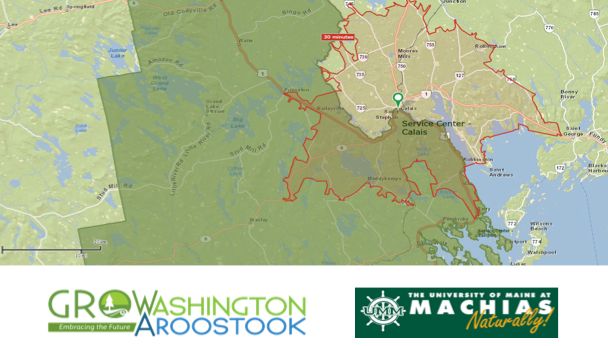 Calais
Calais
There were 3,930 individuals in 1,284 households located within a 30-minute drive from Calais as of 2013. Approximately 83 percent of these households had annual incomes of less than $75,000. Forecast data for 2018 shows population and average age remaining statistically flat, and median age increasing from 47.5 in 2013 to 48.8 in 2018. Per capita income is projected to increase by about 11 percent during this five-year period, dropping the number of households with incomes of less than $75,000 to 77 percent.
Eastport
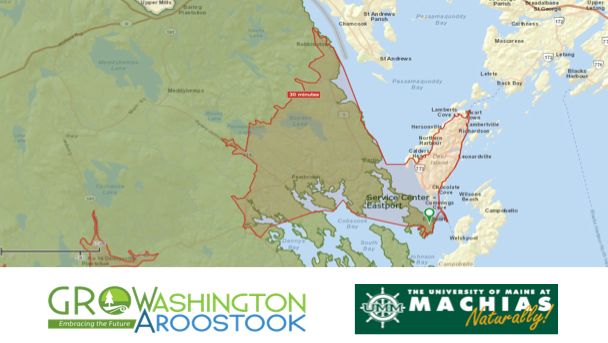 Eastport had the sparsest population and the oldest median age among the commuting areas included in the study. There were 3,204 individuals in 1,472 households located within a 30-minute drive from Eastport as of 2013. Approximately 87 percent of these households had annual incomes of less than $75,000. Forecast data for 2018 shows population and average age remaining statistically flat, and median age increasing from 50.3 in 2013 to 51.7 in 2018. Per capita income is projected to increase by about 15 percent during this five-year period, dropping the number of households with incomes of less than $75,000 to 82 percent.
Eastport had the sparsest population and the oldest median age among the commuting areas included in the study. There were 3,204 individuals in 1,472 households located within a 30-minute drive from Eastport as of 2013. Approximately 87 percent of these households had annual incomes of less than $75,000. Forecast data for 2018 shows population and average age remaining statistically flat, and median age increasing from 50.3 in 2013 to 51.7 in 2018. Per capita income is projected to increase by about 15 percent during this five-year period, dropping the number of households with incomes of less than $75,000 to 82 percent.
Machias
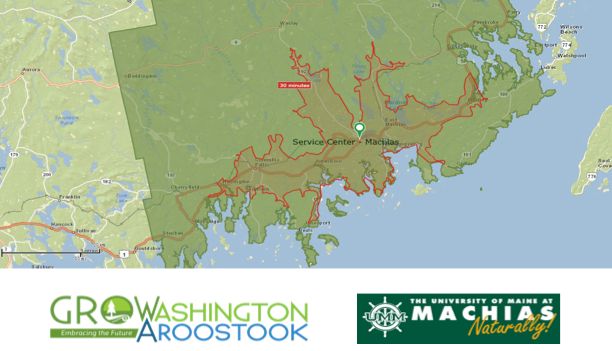 Machias had the youngest median age among the commuting areas included in the study. There were 8,464 individuals in 3,578 households located within a 30?minute drive from Machias as of 2013. Approximately 83 percent of these households had annual incomes of less than $75,000. Forecast data for 2018 shows population and average age remaining statistically flat, and median age increasing from 44.9 in 2013 to 46.3 in 2018. Per capita income is projected to increase by about 11 percent during this five-year period, dropping the number of households with incomes of less than $75,000 to 76 percent.
Machias had the youngest median age among the commuting areas included in the study. There were 8,464 individuals in 3,578 households located within a 30?minute drive from Machias as of 2013. Approximately 83 percent of these households had annual incomes of less than $75,000. Forecast data for 2018 shows population and average age remaining statistically flat, and median age increasing from 44.9 in 2013 to 46.3 in 2018. Per capita income is projected to increase by about 11 percent during this five-year period, dropping the number of households with incomes of less than $75,000 to 76 percent.
Milbridge
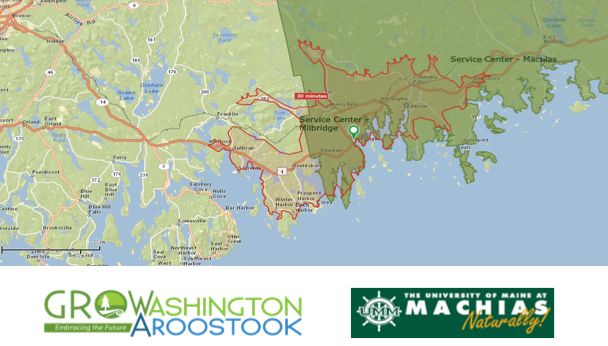 Milbridge had the densest population among the commuting areas included in the study. It also had the highest per capita income, largely attributable to a higher percentage of residents with annual incomes of $150,000 or higher. There were 9,761 individuals in 4,278 households located within a 30?minute drive from Milbridge as of 2013. 80 percent of these households had annual incomes of less than $75,000. Forecast data for 2018 shows population and average age remaining statistically flat, and median age increasing from 47.5 in 2013 to 48.9 in 2018. Per capita income is projected to increase by about 12 percent during this five-year period, dropping the number of households with incomes of less than $75,000 to 73 percent.
Milbridge had the densest population among the commuting areas included in the study. It also had the highest per capita income, largely attributable to a higher percentage of residents with annual incomes of $150,000 or higher. There were 9,761 individuals in 4,278 households located within a 30?minute drive from Milbridge as of 2013. 80 percent of these households had annual incomes of less than $75,000. Forecast data for 2018 shows population and average age remaining statistically flat, and median age increasing from 47.5 in 2013 to 48.9 in 2018. Per capita income is projected to increase by about 12 percent during this five-year period, dropping the number of households with incomes of less than $75,000 to 73 percent.
Forecast data for 2018 shows population and average age remaining statistically flat, and median age increasing from 47.5 in 2013 to 48.9 in 2018. Per capita income is projected to increase by about 12 percent during this five-year period, dropping the number of households with incomes of less than $75,000 to 73 percent.
The socioeconomic data indicate, more than 80 percent of all Washington County households living within a 30-mile radius of major employment centers currently earn less than $75,000 per year, and these statistics will not change radically within the next five years. Washington County’s service center communities are also statistically older than both the Maine average (42.7) and the county average (46.1). This is not surprising, as older residents tend to use more service center amenities, and moving closer allows them to access more services while driving fewer miles. Retirees (and younger adults with disabilities that preclude driving) will also benefit from any improvements to public transit and ride?sharing programs that are primarily intended to promote workforce development.
Current Practice
 Current workers in the four service center regions might be induced to switch from their individual daily commutes to a new ride-sharing program or public transit service, assuming the service was available, affordable, and convenient. According to the Census Transportation Planning Products website:
Current workers in the four service center regions might be induced to switch from their individual daily commutes to a new ride-sharing program or public transit service, assuming the service was available, affordable, and convenient. According to the Census Transportation Planning Products website:
- ~ 75% of all workers in Washington County currently drive themselves to work, with no other passengers.
- ~ 10% participate in a two-person carpool.
- ~ 5% work at home or telecommute.
- ~ 5% walk to work.
- ~ 2% participate in a three-person carpool.
- ~ 1% take a taxi, motorcycle, or “other means” not listed in the survey. (In Washington County, ATV and snowmobile are both likely commuter travel modes, particularly along the Down East Sunrise Trail.)
- Less than 0.1% either use public transit or ride their bicycle to work.
The total adds up to over 100 percent because census respondents are asked to name ALL the travel modes they used to get to work during the week prior to the census.
These figures are not surprising, since the existing public transit service in Washington County is generally not commuter-friendly and the highway system in Washington County is generally not bicycle-friendly. The bicycling figure may be artificially low, however; the census is taken in April and asks about travel mode to work during the week prior to the census, when wintry conditions may discourage all but the most avid bicyclist. Anecdotal evidence in the Machias area suggests that people do bicycle regularly on the Down East Sunrise Trail during morning and evening commuter hours between May and October, and on warm dry days in other months. However, these bicyclists have not been surveyed to determine whether they are commuting, exercising, or riding for pleasure.
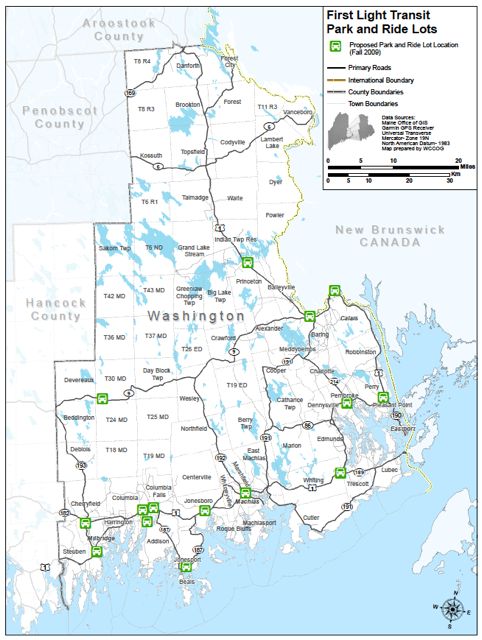 In a transportation survey of Washington County residents in 2009 (summarized in the final 2001 report: Developing Community Access to Transit in Washington County), approximately 42 percent responded affirmatively when asked, “Would you like to share rides to save money?” About 23 percent stated that they would not want to share rides under any circumstances, and the remaining 35.5 percent said “Maybe, if…” where they were encouraged to fill in the open-ended response with their personal reservations about ride?sharing. The “Maybe” responses all expressed one or more common themes:
In a transportation survey of Washington County residents in 2009 (summarized in the final 2001 report: Developing Community Access to Transit in Washington County), approximately 42 percent responded affirmatively when asked, “Would you like to share rides to save money?” About 23 percent stated that they would not want to share rides under any circumstances, and the remaining 35.5 percent said “Maybe, if…” where they were encouraged to fill in the open-ended response with their personal reservations about ride?sharing. The “Maybe” responses all expressed one or more common themes:
- If I already knew the people I’d be riding with, or if I could meet them ahead of time to ensure compatibility (one person said “no smokers”)
- If it was convenient (easy pickup and drop-off, not a lot of wasted time waiting for others to arrive, everyone travels to the same destination at the same time of day, ability to flex the schedule or cancel on short notice when necessary)
- If it was a long drive
- If gasoline becomes more expensive
Conclusions
Interpolating from these survey results, it appears that up to 60 percent of working residents in the four service center regions could be induced to trade in their single-occupant daily commutes for a transit ride or ride-sharing arrangement, at least for a portion of their work week. A marketing campaign to “convert” existing commuters to public transit, carpooling, or vanpooling would also benefit job?hunters, who could seek new or better employment in the service center region as a direct result of improved access to reliable daily transportation between home and work.
Although the scope of the current GROWashington-Aroostook initiative did not allow for a formal economic cost-benefit analysis, the positive economic impacts of a workforce-oriented transportation alternative could be significant for low?to-moderate income households, the regional business community, and environmental air quality (through reduced carbon emissions with fewer vehicles on the road on a daily basis).
The startup of a new workforce-oriented public transportation initiative could also create new job opportunities for regional transit agency drivers, maintenance workers, office staff, and system managers, and the revenues from this program could make up for reduced revenues from MaineCare clients following the switch in 2013 to an externally managed brokerage system.

Share this content: